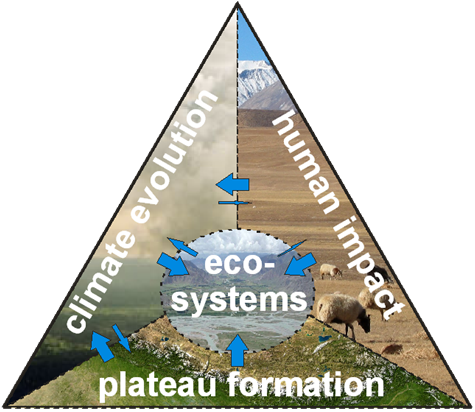Vortrag, Continents under Climate Change - Conference on the Occasion of the 200th Anniversary of the Humboldt-Universität zu Berlin, Berlin: 21.04.2010 - 23.04.2010
Abstract:
The Tibetan Plateau is considered as one of the world's regions forming a tipping point in the climate system. A large number of glaciers are found in the high-mountain ranges on and at the borders of the Tibetan Plateau, contributing to the runoff from major Asian rivers. Climate variability and its consequences for glacial systems is thus of major interest both for scientists and human living in the affected drainage basins. Climate variability and subsequent glacier response has, for instance, led to changes in amount and seasonality of river runoff, formation of glacial lakes, glacial lake outburst floods (GLOF) and lake-level changes in large lakes like Nam Co. Unfortunately, the Tibetan Plateau is also one of the world's regions where data from long-term climate and glacier observations are scarce. For instance, no climate records are available for Tibetan stations above 4'800 m a.s.l.. In combination with yet existing gaps in our present knowledge of glacier processes and climate-glacier interactions the lack of data is a source of uncertainty in assessing the consequences of climate changes for environment and human living. The Intergovernmental Panel on Climate Change (IPCC) has recently been under public pressure due to an ongoing discussion on a statement referring to the disappearance of Himalayan glaciers within the next decades, and has consequently improved its review procedures to avoid referencing to publications of ambiguous quality. This problem that has negatively influenced IPCC's image as a world-leading institution demonstrates the importance of ongoing climatological-glaciological research on the Tibetan Plateau. Both the Deutsche Forschungsgemeinschaft (DFG) and the German Federal Ministry of Education and Research (BMBF) have started or will soon start research programmes with substantial funds also allocated to climate and glacier studies. One of these research projects is entitled "Dynamic Response of Glaciers on the Tibetan Plateau on Climate Change (DynRG-TiP)", funded by the DFG since 2008 as part of the Priority Programme 1372 "Tibetan Plateau - Formation, Climate, Ecosystems (TiP). It is jointly carried by the research groups of the authors in close cooperation with researchers from the Institute of Tibetan Plateau Research (ITP) of the Chinese Academy of Sciences (CAS). The presentation will show new results from studies part of DynRG-TiP for the western Nyainqentanglha Mountains near Nam Co, where the ITP operates one of the bestequipped research stations on the Tibetan Plateau.

